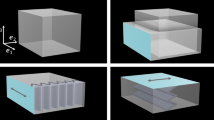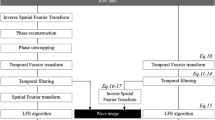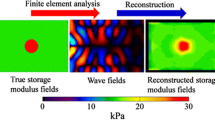Abstract
Purpose
The viscoelasticity (storage modulus and loss modulus) of living tissues is known to be related to diseases. Magnetic resonance elastography (MRE) is a quantitative method for non-invasive measuring viscoelasticity. The viscoelasticity is calculated from the elastic wave images using an inversion algorithm. The estimation accuracy of the inversion algorithm is degraded by background noise. This study aims to propose novel inversion algorithms that are applicable for noisy elastic wave images.
Methods
The proposed algorithms are based on the Voigt-type viscoelastic equation. The algorithms are designed to improve the noise robustness by avoiding direct differentiation of measurement data by virtue of Green's formula. Similarly, stabilization is introduced to the curl-operator which works to eliminate the compression waves in measurement data. To clarify the characteristics of the algorithms, the proposed algorithms were compared with the conventional algorithms using isotropic and anisotropic voxel numerical simulations and phantom experimental data.
Results
From the results of the numerical simulations, normalized errors of stiffness of proposed algorithms were 3% or less. The proposed algorithms mostly showed better results than the conventional algorithms despite noisy elastic wave images. From the gel phantom experiment, we confirmed the same tendency as the characteristics of the algorithms observed in the numerical simulation results.
Conclusion
We have developed a novel inversion algorithm and evaluated it quantitatively. The results confirm that the proposed algorithms are highly quantitative and noise-robust methods for estimating storage and loss modulus regardless of noise, voxel anisotropy, and propagation direction. Therefore, the proposed algorithms will appropriate to various three-dimensional MRE systems.










Similar content being viewed by others
References
Muthpillai R, Lomas DJ, Rossman PF, Greenleaf JF, Manduca A, Ehman RL (2020) Magnetic resonance elastography by direct visualization of propagating acoustic strain waves. Science 269:1854–1857. https://doi.org/10.1126/science.7569924
Liang Y, Li D (2020) Magnetic resonance elastography in staging liver fibrosis in non-alcoholic fatty liver disease: a pooled analysis of the diagnostic accuracy. BMC Gastroenterol 20(1):89. https://doi.org/10.1186/s12876-020-01234-x
Singh S, Venkatesh SK, Loomba R, Wang Z, Sirlin C, Chen J, Yin M, Miller FH, Low RN, Hassanein T, Godfrey EM, Asbach P, Murad MH, Lomas DJ, Talwalkar JA, Ehman RL (2016) Magnetic resonance elastography for staging liver fibrosis in non-alcoholic fatty liver disease: a diagnostic accuracy systematic review and individual participant data pooled analysis. Eur Radiol 26(5):1431–1440. https://doi.org/10.1007/s00330-015-3949-z
Yin M, Talwalker JA, Glaser KJ, Manduca A, Grimm RC, Rossman PJ, Fidler JL, Ehman RL (2007) Assessment of hepatic fibrosis with magnetic resonance elastography. Clin Gastroenterol Hepatol 5(10):1207–1213. https://doi.org/10.1016/j.cgh.2007.06.012
Yoon JH, Lee JM, Joo I, Lee ES, Sohn JY, Jang SK, Lee KB, Han JK, Choi BI (2014) Hepatic fibrosis: prospective comparison of MR elastography and US shear-wave elastography for evaluation. Radiology 273(3):772–782. https://doi.org/10.1148/radiol.14132000
Yoshimitsu K, Mitsufuji T, Shinagawa Y, Fujimitsu R, Morita A, Urakawa H, Hayashi H, Takano K (2016) MR Elastography of the liver at 3.0T in diagnosing liver fibrosis grades; preliminary clinical experience. Eur Radiol 26(3):656–663. https://doi.org/10.1007/s00330-015-3863-4
Thompson SM, Wang J, Chandan VS, Glaser KJ, Roberts LR, Ehman RL, Venkatesh SK (2017) MR elastography of hepatocellular carcinoma: correlation of tumor stiffness with histopathology features-Preliminary findings. Magn Reson Imaging 37:41–45. https://doi.org/10.1016/j.mri.2016.11.005
Li J, Zormpas-Petridis K, Boult JKR, Reeves EL, Heindl A, Vinci M, Lopes F, Cummings C, Springer CJ, Chesler L, Jones C, Bamber JC, Yuan Y, Sinkus R, Jamin Y, Robinson SP (2019) Investigating the contribution of collagen to the tumor biomechanical phenotype with noninvasive magnetic resonance elastography. Cancer Res 79(22):5874–5883. https://doi.org/10.1158/0008-5472.CAN-19-1595
Hiscox LV, Johnson CL, Barnhill E, McGarry MDJ, Huston J, van Beek EJR, Starr JM, Roberts N (2016) Magnetic resonance elastography (MRE) of the human brain: technique, findings and clinical applications. Phys Med Biol 61(24):R401–R437. https://doi.org/10.1088/0031-9155/61/24/R401
Murphy MC, Huston J 3rd, Ehman RL (2019) MR elastography of the brain and its application in neurological diseases. Neuroimage 187:176–183. https://doi.org/10.1016/j.neuroimage.2017.10.008
Garteiser P, Doblas S, Daire J, Wagner M, Leitao H, Vilgrain V, Sinkus R, Beers BEV (2012) MR elastography of liver tumours: value of viscoelastic properties for tumour characterization. Eur Radiol 22(10):2169–2177. https://doi.org/10.1007/s00330-012-2474-6
Pagé G, Tardieu M, Gennisson J, Besret L, Garteiser P, Beers BEV (2021) Tumor solid stress: assessment with MR elastography under compression of patient-derived hepatocellular carcinomas and cholangiocarcinomas xenografted in mice. Cancers 13(8):1891. https://doi.org/10.3390/cancers13081891
Knutsson H, Westin CF, Granlund G (1994) Local multiscale frequency and bandwidth estimation. Proc IEEE Int Conf Image Process 1:36–40
Manduca A, Muthupillai R, Rossman P, Greenleaf JF, Ehman RL (1996) Local wavelength estimation for magnetic resonance elastography. Proc IEEE Int Conf Image Process 3:527–530
Oliphant TE, Manduca A, Ehman RL, Greenleaf JF (2001) Complex-valued stiffness reconstruction for magnetic resonance elastography by algebraic inversion of the differential equation. Magnet Resonance Med 45:299–310. https://doi.org/10.1002/1522-2594(200102)45:2%3c299::aid-mrm1039%3e3.0.co;2-o
Romano AJ, Shirron JJ, Bucaro JA (1998) On the noninvasive determination of material parameters from a knowledge of elastic displacements theory and numerical simulation. IEEE Trans Ultrason Ferroelectr Freq Control 45:751–759. https://doi.org/10.1109/58.677725
Manduca A, Oliphant TE, Dresner MA, Mahowald JL, Kruse SA, Amromin E, Felmlee JP, Greenleaf JF, Ehman RL (2001) Magnetic resonance elastography: non-invasive mapping of tissue elasticity. Med Image Anal 5(4):37–254. https://doi.org/10.1016/s1361-8415(00)00039-6
Yin M, Talwalkar JA, Glaser KJ, Venkatesh SK, Chen J, Manduca A, Ehman RL (2011) Dynamic postprandial hepatic stiffness augmentation assessed with MR elastography in patients with chronic liver disease. Am J Roentgenol 197(1):64–70. https://doi.org/10.2214/AJR.10.5989
Yasar TK, Wagner M, Bane O, Besa C, Babb JS, Kannengiesser S, Fung M, Ehman RL, Taouli B (2016) Inter-platform reproducibility of liver and spleen stiffness measured with MR elastography. J Magn Reson Imaging 43(5):1064–1072. https://doi.org/10.1002/jmri.25077
Silva AM, Grimm RC, Glazer KJ, Fu Y, Wu T, Ehman RL, Silva AC (2015) Magnetic resonance elastography: evaluation of new inversion algorithm and quantitative analysis method. Abdom Imaging 40(4):810–817. https://doi.org/10.1007/s00261-015-0372-5
Murphy MC, Manduca A, Trzasko JD, Glaser KJ, Huston J 3rd, Ehman RL (2018) Artificial neural networks for stiffness estimation in magnetic resonance elastography. Magn Reson Med 80(1):351–360. https://doi.org/10.1002/mrm.27019
Jiang Y, Fujiwara H, Nakamura G (2011) Approximate steady state models for magnetic resonance elastography. SIAM J Appl Math 71(6):1965–1989. https://doi.org/10.1137/100781882
Sinkus R, Tanter M, Xydeas T, Catheline S, Bercoff J, Fink M (2005) Viscoelastic shear properties of in vivo breast lesions measured by MR elastography. Magn Reson Imaging 23(2):159–165. https://doi.org/10.1016/j.mri.2004.11.060
Mariappan YK, Glaser KJ, Ehman RL (2010) Magnetic resonance elastography: a review. Clin Anat 23(5):497–511. https://doi.org/10.1002/ca.21006
Gill HE, Lisanti CJ, Schwope RB, Kim J, Katz M, Harrison S (2020) Technical success rate of MR elastography in a population without known liver disease. Abdom Radiol 46(2):590–596. https://doi.org/10.1007/s00261-020-02652-x
Acknowledgements
The work was supported in part by JSPS KAKENHI JP17H02115 and JP20H01821.
Author information
Authors and Affiliations
Corresponding author
Ethics declarations
Conflict of interest
The authors declare that they have no conflict of interest.
Ethical approval
This article does not contain any studies with human participants performed by any of the authors.
Informed consent
This articles does not contain patient data.
Additional information
Publisher's Note
Springer Nature remains neutral with regard to jurisdictional claims in published maps and institutional affiliations.
Rights and permissions
About this article
Cite this article
Takeda, T., Fujiwara, H. & Suga, M. Development of three-dimensional integral-type reconstruction formula for magnetic resonance elastography. Int J CARS 16, 1947–1956 (2021). https://doi.org/10.1007/s11548-021-02517-8
Received:
Accepted:
Published:
Issue Date:
DOI: https://doi.org/10.1007/s11548-021-02517-8




